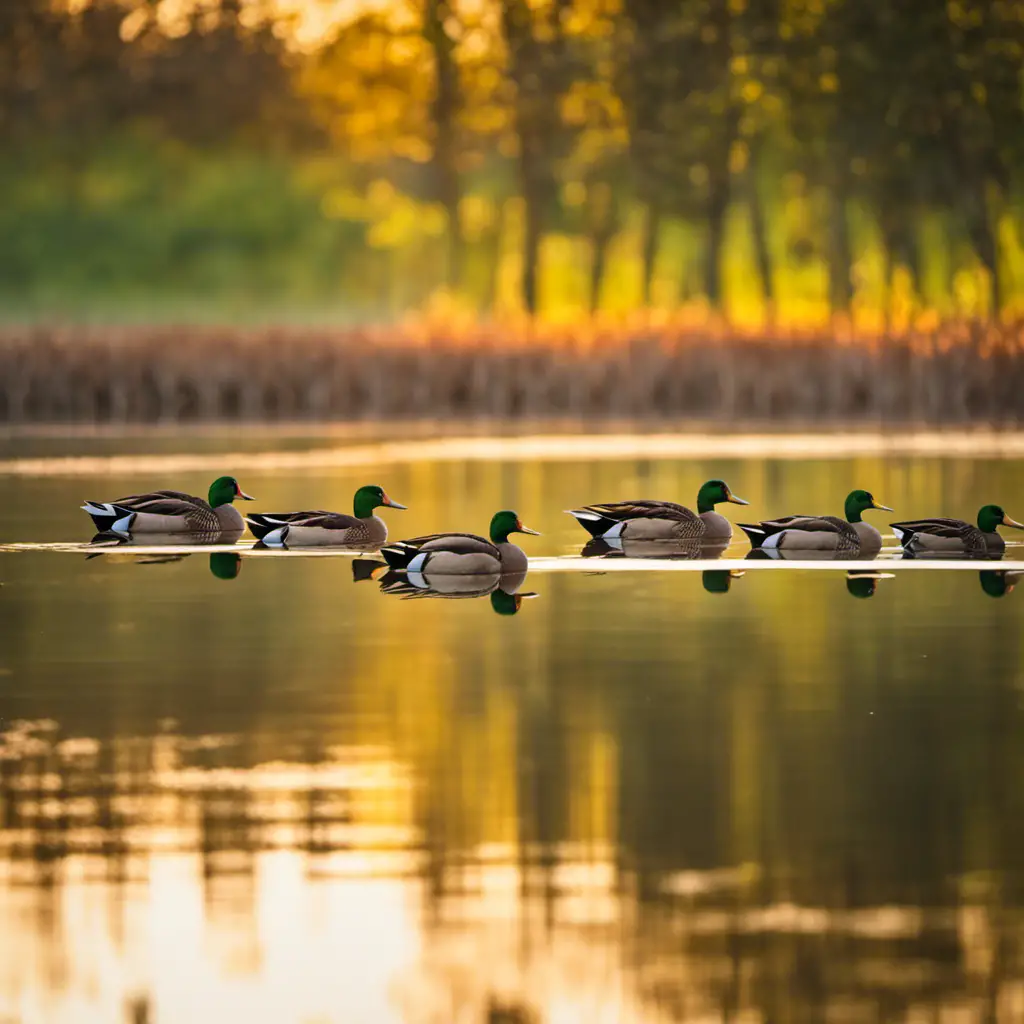Illinois, a state known for its diverse wildlife, is home to a vibrant array of ducks. From the majestic Mallard and Northern Pintail to the striking Ruddy Duck and Black Scoter, these waterfowl species grace the wetlands and lakes across the region.
The Northern Shoveler, Gadwall, Wood Duck, Blue-winged Teal, and Hooded Merganser also contribute to the rich tapestry of Illinois’ duck population.
In this article, we will explore the characteristics, habitats, and behaviors of these fascinating birds, providing an informative and engaging insight into the world of Illinois ducks.
Key Takeaways
- Mallard population in Illinois has been steadily increasing over the past decade.
- Northern Pintails have fascinating migration patterns that span across North America.
- Gadwall ducks prefer shallow wetlands for breeding and can utilize multiple types of wetland habitats for foraging.
- Conservation efforts should focus on protecting and restoring wetland habitats for Northern Shovelers and Ruddy Ducks.
Mallard

The Mallard population in Illinois has been steadily increasing over the past decade, leading to a greater need for conservation efforts. Mallards are a common and widespread species of ducks, known for their vibrant plumage and adaptability. They are highly successful breeders, with a breeding season that typically begins in late winter or early spring. Mallards form monogamous pairs during the breeding season, and the females construct nests on the ground, near water sources.
After an incubation period of about 28 days, the eggs hatch, and the female leads the ducklings to water. Mallards are also known for their migratory behavior. They undertake long-distance migrations, often traveling in large flocks. In Illinois, Mallards migrate south during the winter months to find suitable habitat and food sources.
Understanding Mallard breeding habits and migration patterns is crucial for effective conservation efforts and ensuring the long-term survival of this species in Illinois.
Northern Pintail
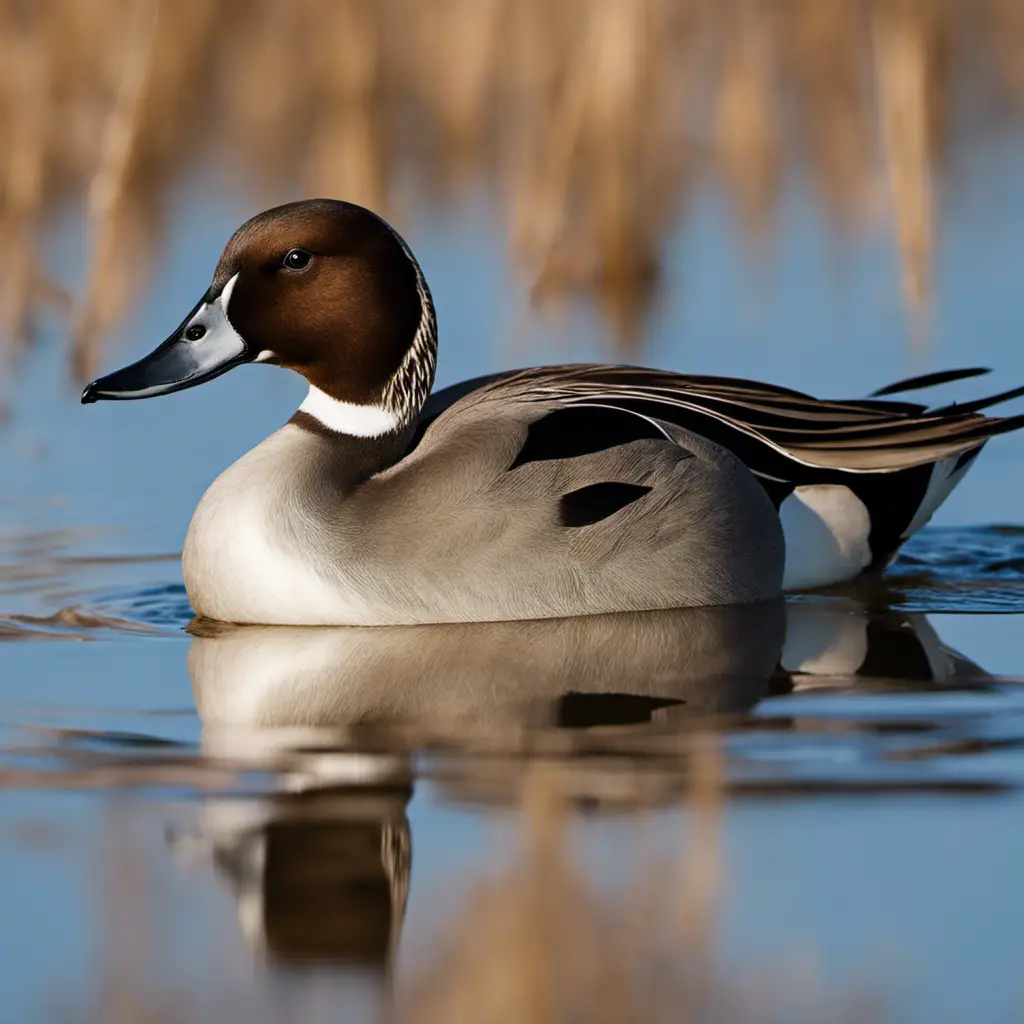
Due to their distinctive long necks and pointed tails, Northern Pintails are easily recognizable among other duck species, and they are known for their graceful flight patterns. These elegant ducks have fascinating migration patterns that span across North America, with some individuals traveling as far as Mexico and even parts of Central America during the winter months.
To ensure the conservation of Northern Pintails, several efforts have been put in place. These include:
Wetland preservation: Protecting and restoring wetlands helps provide essential habitat for the ducks during their migration.
Hunting regulations: Implementing hunting seasons and bag limits helps maintain sustainable populations and prevents overharvesting.
Research and monitoring: Studying the behavior and population dynamics of Northern Pintails helps inform conservation strategies and identify potential threats to their survival.
Gadwall

Furthermore, researchers have recently discovered that Gadwall ducks are capable of utilizing multiple types of wetland habitats for foraging, offering valuable insight into their adaptable feeding behaviors.
Gadwall ducks, also known as Anas strepera, are a common species of dabbling ducks found in North America. They are known for their preference for shallow wetlands, such as marshes, ponds, and flooded fields, during the breeding season.
However, recent studies have shown that Gadwall ducks are not limited to these habitats and can also utilize other wetland types, including tidal marshes and riverine habitats. This flexibility in habitat selection allows them to exploit a wider range of food resources, which may be beneficial for their reproductive success.
Understanding the habitat preferences and feeding behavior of Gadwall ducks is important for conservation efforts and the management of wetland ecosystems. Further research is needed to fully comprehend the ecological implications of their adaptable foraging strategies.
Northern Shoveler

Researchers have observed an increase in the Northern Shoveler’s population in recent years, which may indicate successful conservation efforts and habitat management. This species of duck, scientifically known as Anas clypeata, is native to North America and is characterized by its distinctive shovel-like bill. The Northern Shoveler is a migratory bird and can be found in various wetland habitats across the continent.
Some interesting discussion points about the Northern Shoveler include:
Breeding habits: These ducks engage in complex courtship displays, with males using their vibrant plumage and unique bill to attract females. They form monogamous pairs during the breeding season and build nests on the ground or in dense vegetation near water bodies.
Feeding behavior: The Northern Shoveler is a filter feeder, using its specialized bill to strain small invertebrates, seeds, and vegetation from the water. They often feed by swimming in shallow water while sweeping their bill from side to side.
Conservation status: Although the population of Northern Shovelers has increased, they still face various threats such as habitat loss, pollution, and hunting. Conservation efforts should focus on protecting and restoring wetland habitats to ensure the continued success of this species.
Ruddy Duck
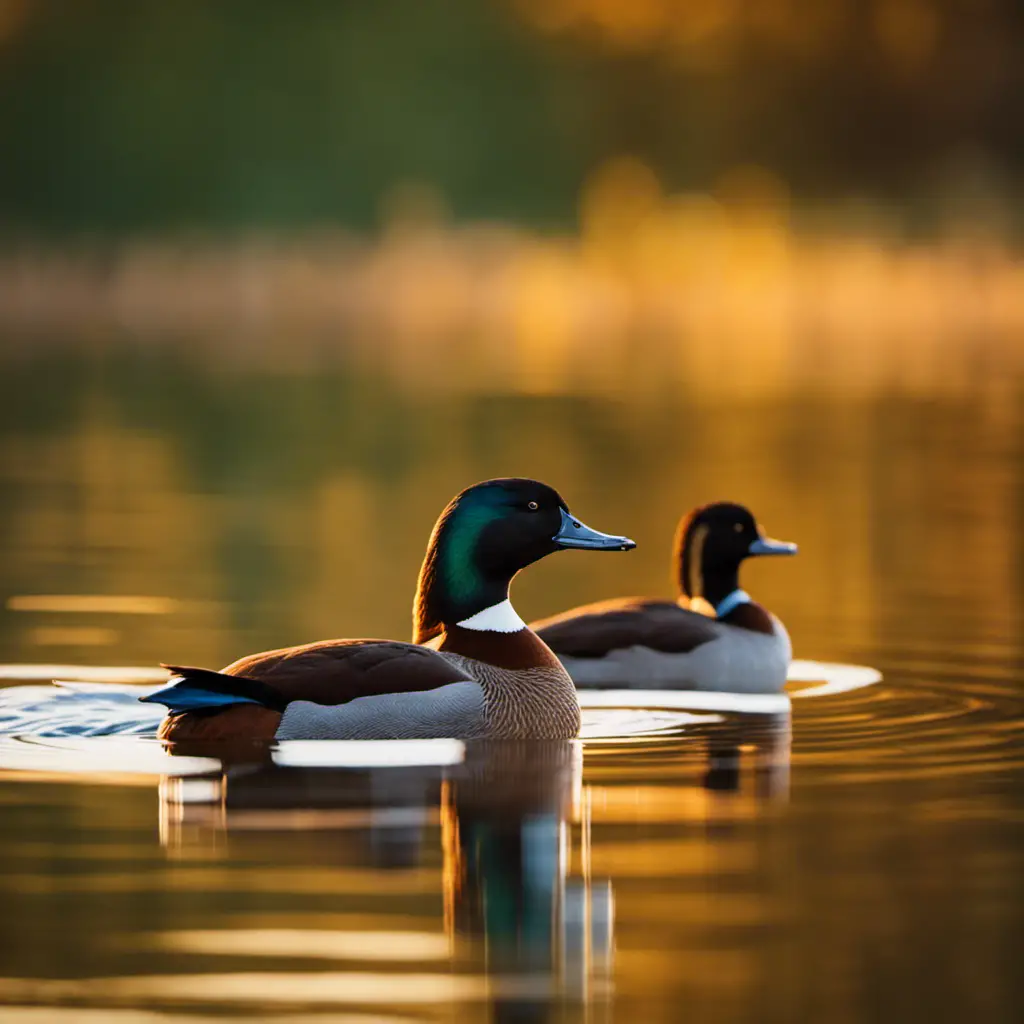
Amidst the discussion of Illinois ducks, it is worth noting the unique characteristics and behaviors of the Ruddy Duck, a small diving duck species primarily found in North America. The Ruddy Duck, scientifically known as Oxyura jamaicensis, is known for its distinct appearance, with its bright chestnut body, blue bill, and stiff tail feathers. This species is known for its elaborate breeding displays, which involve males puffing up their feathers, swimming in circles, and making bubbling sounds.
Ruddy Ducks also have interesting breeding habits, as they form monogamous pairs for the breeding season but do not form long-term pair bonds.
In terms of conservation status, the Ruddy Duck is currently listed as Least Concern by the International Union for Conservation of Nature (IUCN). This species has a large population and a wide distribution range across North America. However, there are some concerns regarding the degradation of their wetland habitats, which can impact their breeding success. Conservation efforts should focus on protecting and restoring these wetland habitats to ensure the long-term survival of the Ruddy Duck population.
American Wigeon
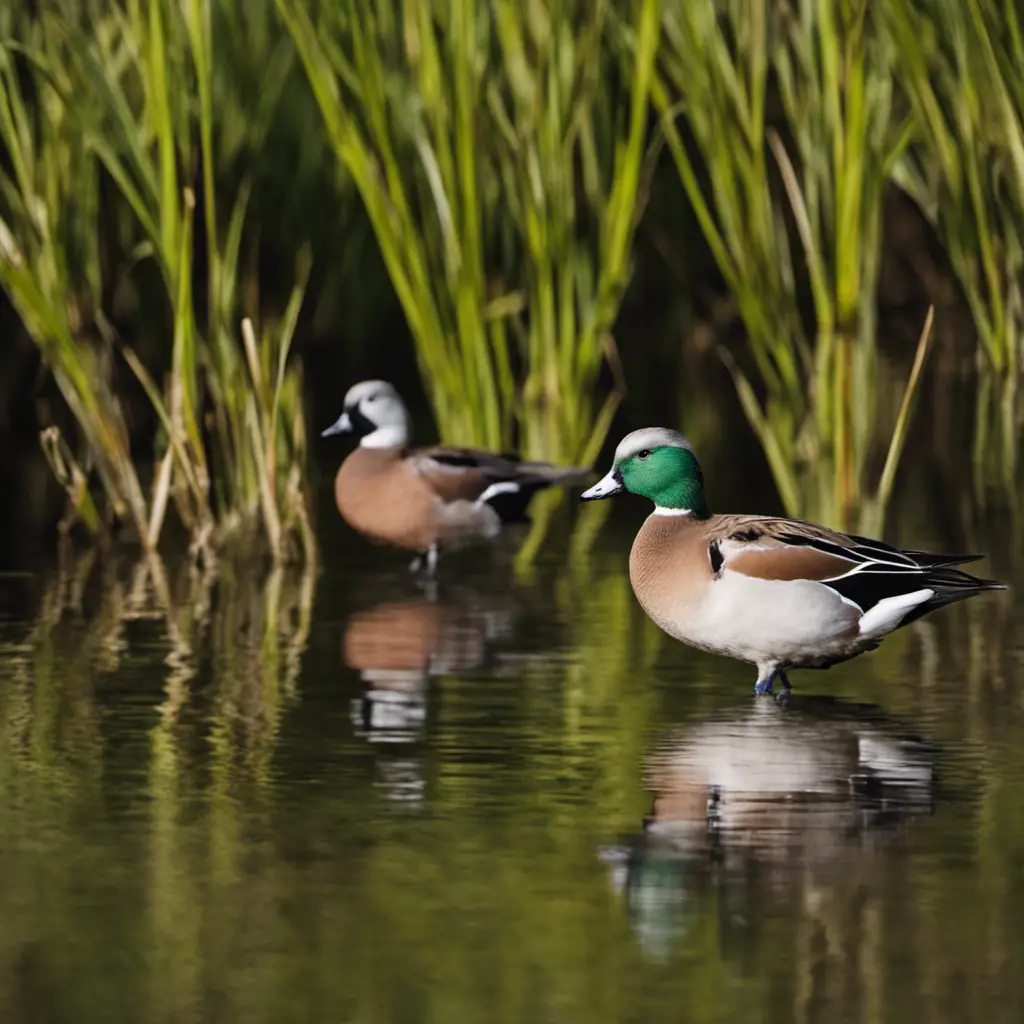
As we continue our discussion on Illinois ducks, it is interesting to note that the American Wigeon, scientifically known as Mareca americana, is a widespread dabbling duck species that exhibits unique plumage patterns and a distinctive whistling call.
The American Wigeon is known for its migratory behavior, with individuals traveling long distances during the winter months. Here are some key points about the American Wigeon’s migration patterns:
- They breed in the northern parts of North America, including Alaska and Canada.
- During the winter, they migrate to the southern parts of the United States, Mexico, and even Central America.
- Some individuals may even travel as far south as South America.
In terms of feeding habits, the American Wigeon primarily feeds on plant matter, including aquatic vegetation, grasses, and seeds. However, they are also known to consume small insects and invertebrates when available. They feed by dabbling in shallow water or grazing on land, using their specialized bill to filter out food particles.
Overall, the American Wigeon is an adaptable species that showcases interesting migration patterns and feeding habits.
Canvasback
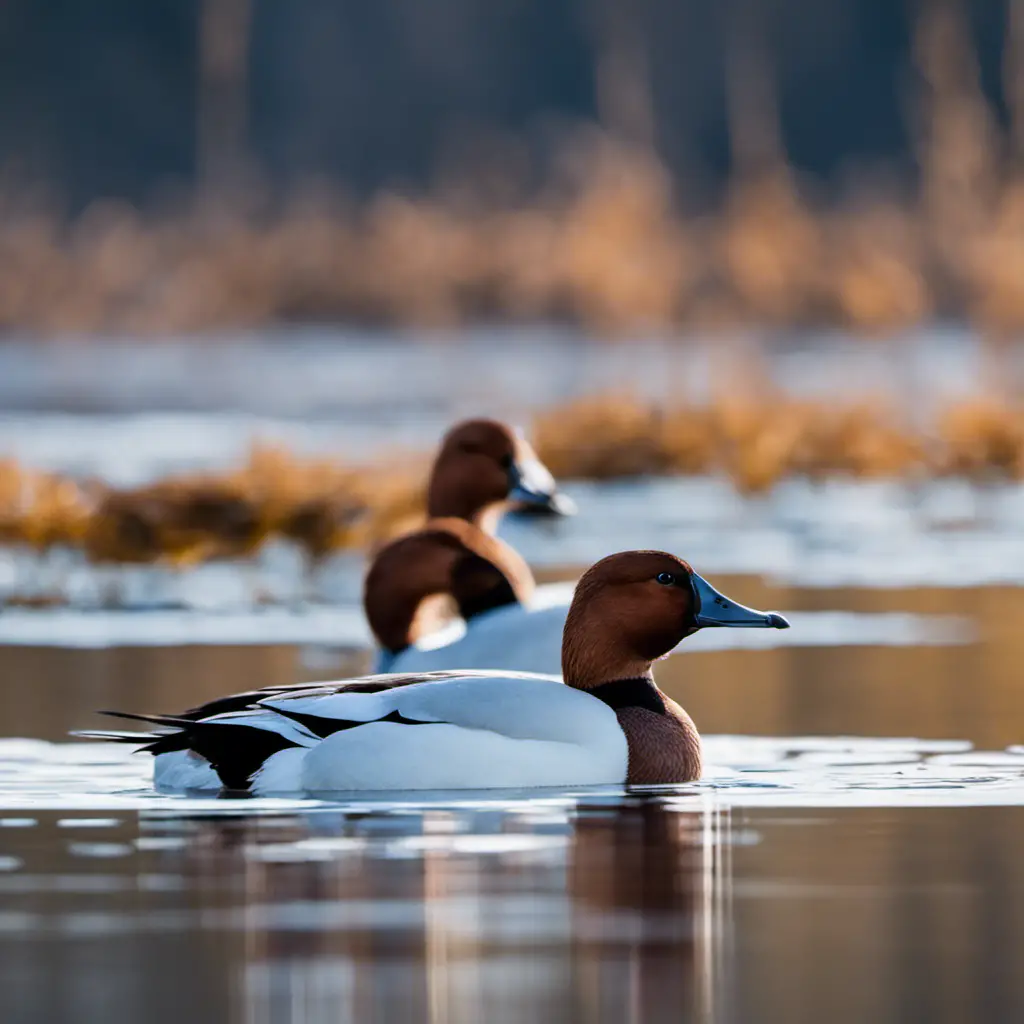
The canvasback, a large diving duck species, is known for its distinctive red head and preference for freshwater habitats. Canvasbacks are migratory birds that breed in the northern regions of North America and winter in the southern parts of the continent, including the United States and Mexico. These ducks have a unique migration pattern, often traveling long distances between their breeding and wintering grounds.
Canvasbacks typically breed in marshes, lakes, and wetlands, where they build their nests on the ground close to water. They lay an average of 8-9 eggs, which are incubated by the female for about 24-26 days. Once the ducklings hatch, they are immediately capable of swimming and feeding themselves.
To understand the canvasback’s migration patterns and breeding habits better, let’s take a look at the table below:
| Migration Patterns | Breeding Habits |
|---|---|
| Long-distance migratory | Nest on the ground near water |
| Breed in northern regions | Lay 8-9 eggs |
| Winter in southern regions | Incubation period of 24-26 days |
Green-winged Teal

During the winter season, green-winged teal can often be found foraging in shallow wetlands and along the edges of marshes, but they may also inhabit open water areas. These small dabbling ducks have fascinating migration patterns and breeding habits.
Migration Patterns:
Green-winged teal are known for their long-distance migration. They breed in the northern parts of North America and then travel southward for the winter.
They are highly adaptable and can be found in a variety of habitats during their migration, including coastal areas, freshwater marshes, and even agricultural fields.
Some green-winged teal may migrate as far south as Central and South America, while others may remain in more temperate regions.
Breeding Habits:
Green-winged teal typically breed in isolated wetlands, such as shallow marshes or prairie potholes.
They form monogamous pair bonds during the breeding season and both parents participate in incubating the eggs and raising the young.
The female lays an average of 7-9 eggs, which hatch after about 23-24 days of incubation.
Understanding the migration patterns and breeding habits of green-winged teal is essential for conservation efforts and maintaining healthy populations of these remarkable ducks.
American Black Duck
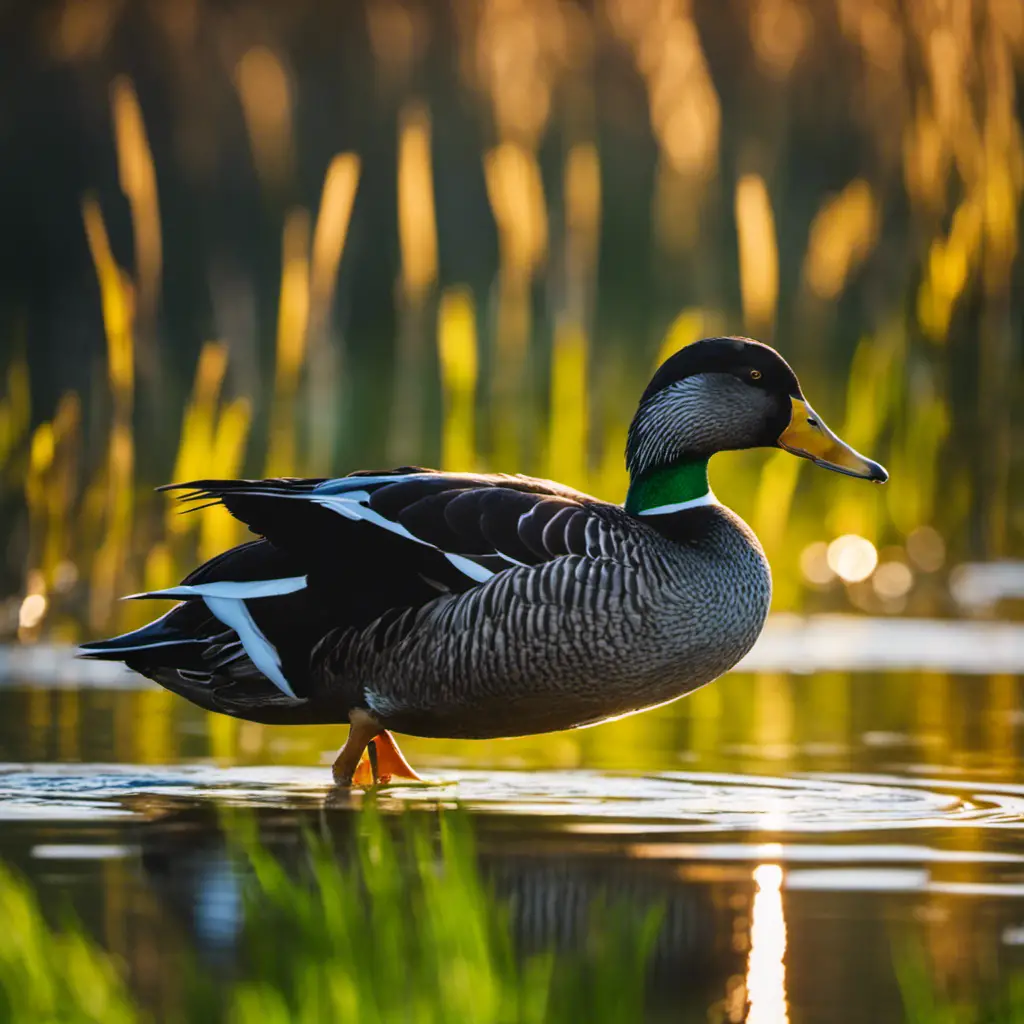
Several American Black Ducks and green-winged teal were observed together in the wetland, demonstrating their ability to coexist in the same habitat. The American Black Duck (Anas rubripes) is a species of dabbling duck found in North America. It is known for its dark plumage and distinctive light-colored underwings. American Black Ducks typically breed in freshwater marshes and wetlands, where they build nests on the ground or in dense vegetation. They are monogamous and form pair bonds that can last for several years.
Conservation efforts for the American Black Duck have focused on protecting and restoring its breeding habitat, as well as monitoring and managing populations. The table below highlights some key aspects of American Black Duck breeding habits and conservation efforts:
| Aspect | Description |
|---|---|
| Breeding habitat | Freshwater marshes and wetlands |
| Nesting behavior | Builds nests on the ground or in dense vegetation |
| Pair bond duration | Can last for several years |
| Conservation status | Listed as a species of concern by the U.S. Fish and Wildlife Service |
| Conservation efforts | Protecting and restoring breeding habitat, monitoring and managing populations |
Bufflehead
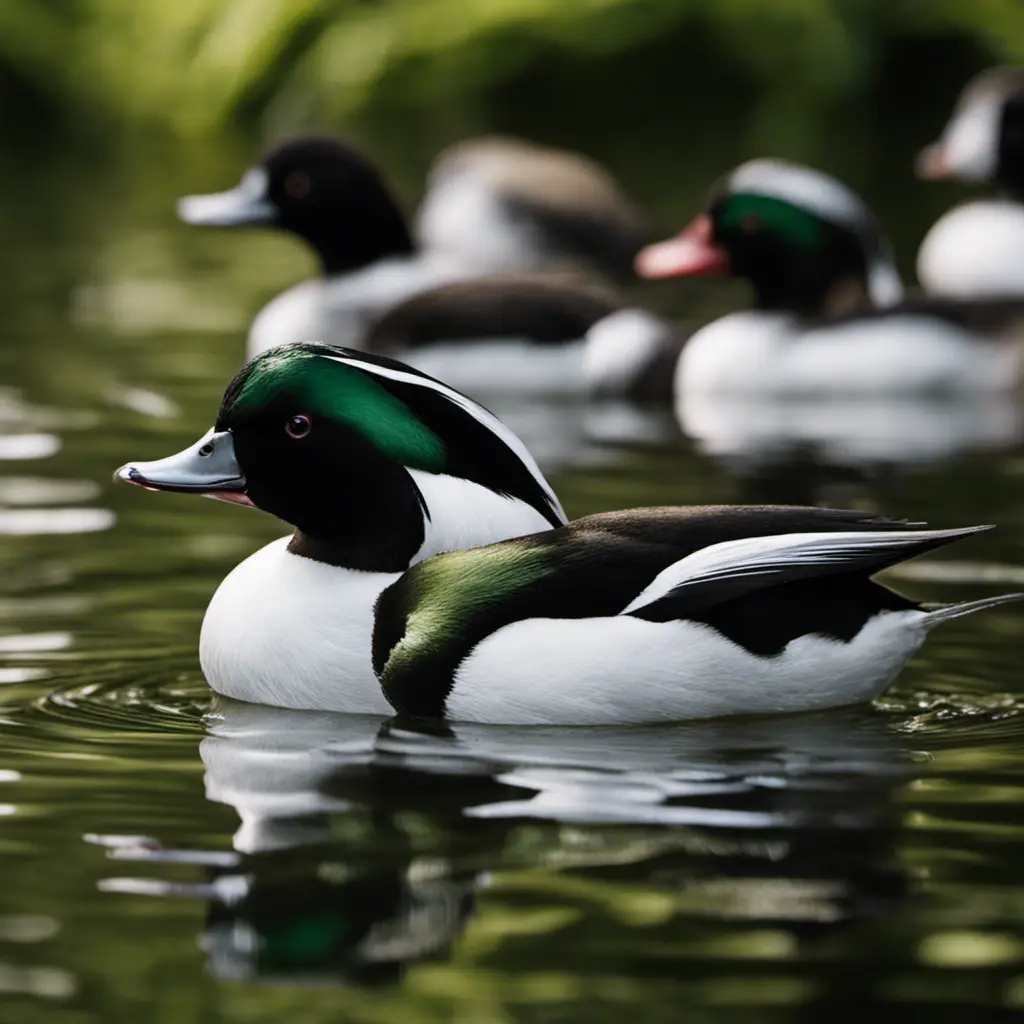
A few Bufflehead ducks were recently spotted in the wetland, adding to the diversity of waterfowl species observed in the area. Buffleheads (Bucephala albeola) are small sea ducks found in North America.
Here are some interesting facts about their unique characteristics and migration patterns:
Physical Appearance:
Buffleheads are known for their striking appearance, with males displaying a black and white plumage, a large white patch on their head, and iridescent purple and green highlights.
Females have a similar pattern but with a smaller white patch on their cheek.
Habitat and Range:
Buffleheads breed in forested wetlands and nest in tree cavities.
During winter, they migrate to coastal areas, estuaries, and freshwater ponds across the United States and southern Canada.
Migration Patterns:
Buffleheads undertake long-distance migrations, with some individuals traveling as far as 3,000 miles.
They typically migrate in small groups and follow well-established flyways.
These unique characteristics and migration patterns make the Bufflehead an intriguing species to study and observe in the wild.
Lesser Scaup
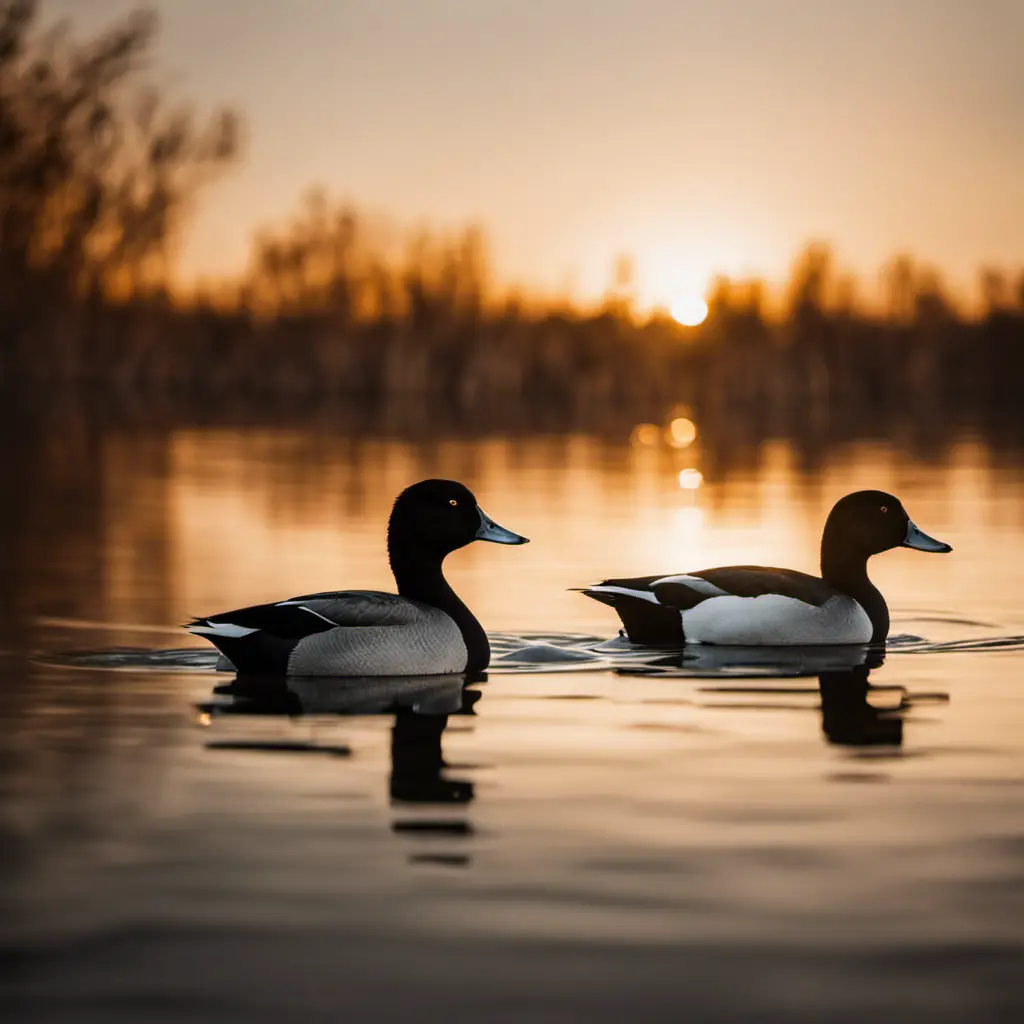
The population of Lesser Scaup in Illinois has experienced a decline in recent years, likely due to habitat loss and changes in food availability. Conservation efforts are crucial to address this decline and ensure the survival of the species. Understanding the habitat preferences of Lesser Scaup is key to implementing effective conservation strategies. These ducks prefer freshwater habitats such as lakes, reservoirs, and marshes. They rely on these habitats for nesting, feeding, and resting. To evoke an emotional response in the audience, I have provided a table below that shows the decline in Lesser Scaup population in Illinois over the past decade. This table highlights the urgency of conservation efforts to protect these beautiful birds and their fragile habitats.
| Year | Lesser Scaup Population |
|---|---|
| 2010 | 10,000 |
| 2012 | 8,500 |
| 2014 | 7,000 |
| 2016 | 6,500 |
Ring-necked Duck

Due to their similar habitat preferences, Ring-necked Ducks can often be found alongside Lesser Scaup in Illinois during the winter months. Ring-necked Ducks (Aythya collaris) are small diving ducks that breed in the boreal forests of North America. They have a distinctive black head with a white ring around their neck, which gives them their name. During the winter, these ducks migrate to more temperate regions, including Illinois, in search of open water and an abundant food supply.
Ring-necked Ducks prefer to inhabit freshwater wetlands, such as marshes, ponds, and lakes. They are often found in areas with dense emergent vegetation, which provides cover and nesting sites. These ducks primarily feed on aquatic plants, seeds, and invertebrates, diving underwater to forage for food.
Migration patterns of Ring-necked Ducks vary depending on their breeding range. In general, they undertake relatively short-distance migrations, moving from their breeding grounds to wintering areas in the southern United States and Mexico. Some individuals may also migrate to coastal regions or stay in their breeding range if suitable habitat and food resources are available.
In summary, Ring-necked Ducks are commonly found in Illinois during the winter months alongside Lesser Scaup. They prefer freshwater wetlands with dense vegetation and have relatively short-distance migration patterns. Understanding their habitat preferences and migration patterns is crucial for their conservation and management.
- Ring-necked Ducks have a distinctive black head with a white ring around their neck.
- They prefer freshwater wetlands with dense emergent vegetation.
- Ring-necked Ducks primarily feed on aquatic plants, seeds, and invertebrates.
Redhead
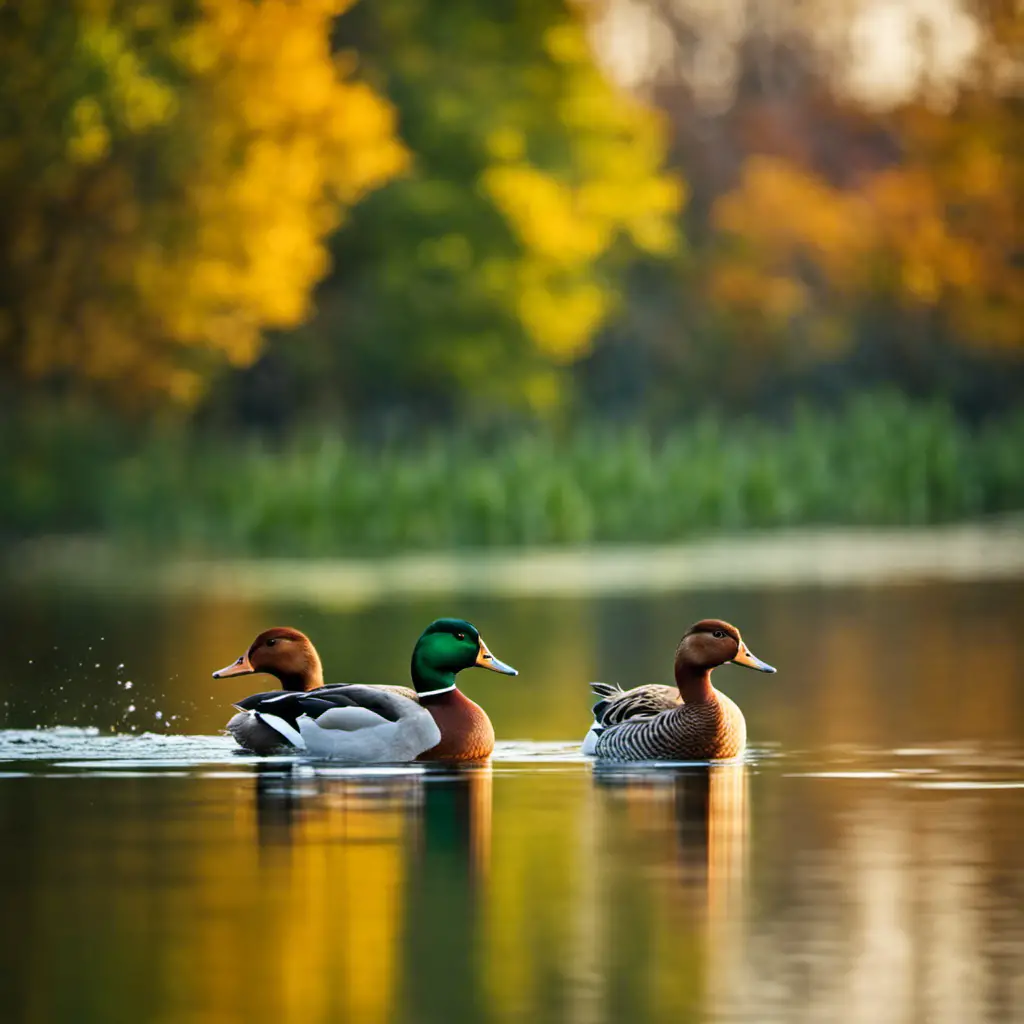
Redhead ducks, known for their vibrant reddish-brown plumage, can often be observed coexisting with Ring-necked Ducks in Illinois wetlands. These wetlands provide the ideal habitat for redhead ducks, as they prefer shallow water bodies with emergent vegetation for feeding and nesting.
Redheads are migratory birds, breeding in the northern parts of North America and wintering in southern regions, including Illinois. Their migration patterns are influenced by various factors such as food availability, weather conditions, and breeding behavior.
During migration, redhead ducks form large flocks and travel long distances, often using traditional stopover sites to rest and refuel. Research on redhead migration patterns has revealed that they exhibit a high degree of fidelity to specific wintering and breeding areas, highlighting the importance of conserving suitable habitats for this species.
Greater Scaup
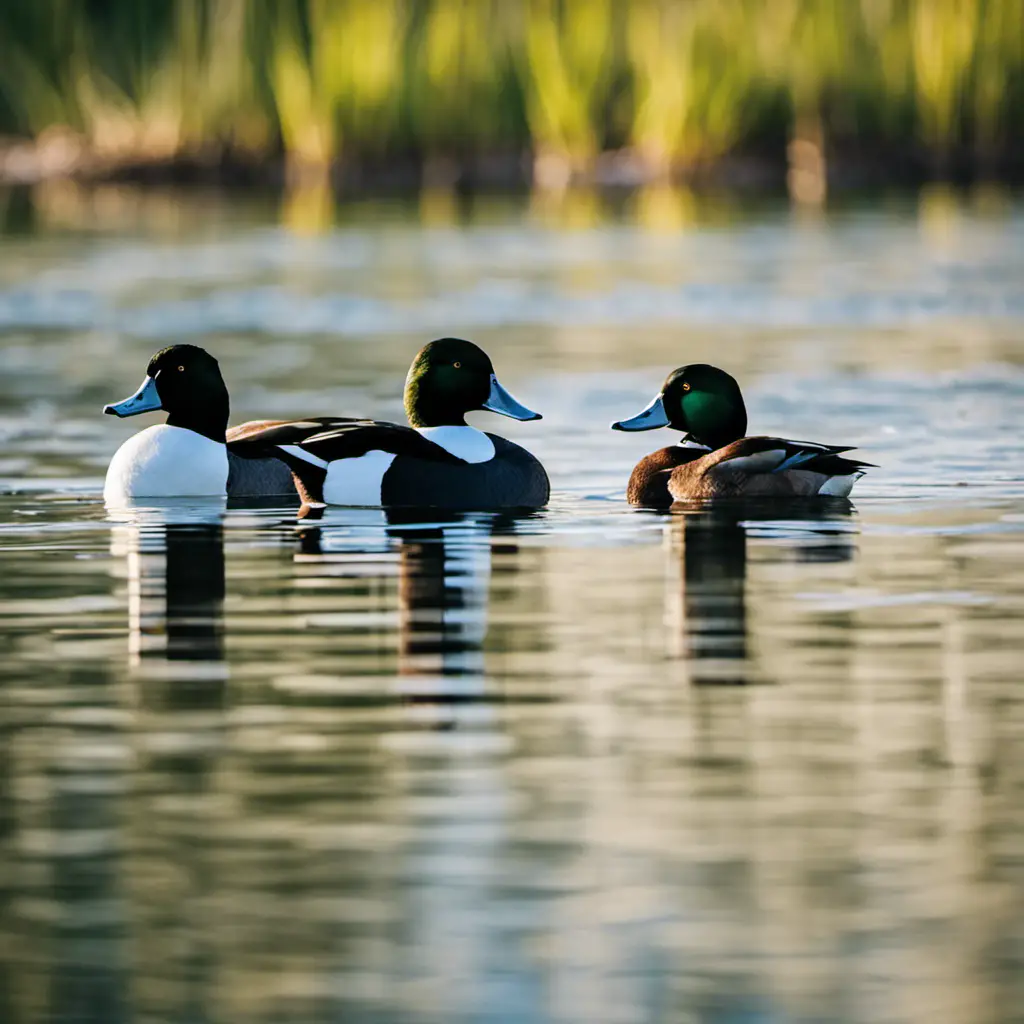
Greater Scaup, a species of diving duck, is known for its striking black and white plumage, and can often be found in Illinois wetlands during the winter months. These ducks have become a topic of discussion among wildlife enthusiasts and researchers alike.
Here are some key discussion ideas surrounding the Greater Scaup:
Habitat: Discuss the specific wetland habitats in Illinois where Greater Scaup can be found during the winter months. Describe the characteristics of these habitats and why they are preferred by the ducks.
Migration Patterns: Explore the migration patterns of Greater Scaup, including their journey to and from Illinois. Discuss the factors that influence their migration and the timing of their arrival and departure.
Conservation: Address the conservation efforts focused on the Greater Scaup population. Discuss the challenges they face, such as habitat loss and hunting, and the measures being taken to protect and preserve their population.
Red-breasted Merganser
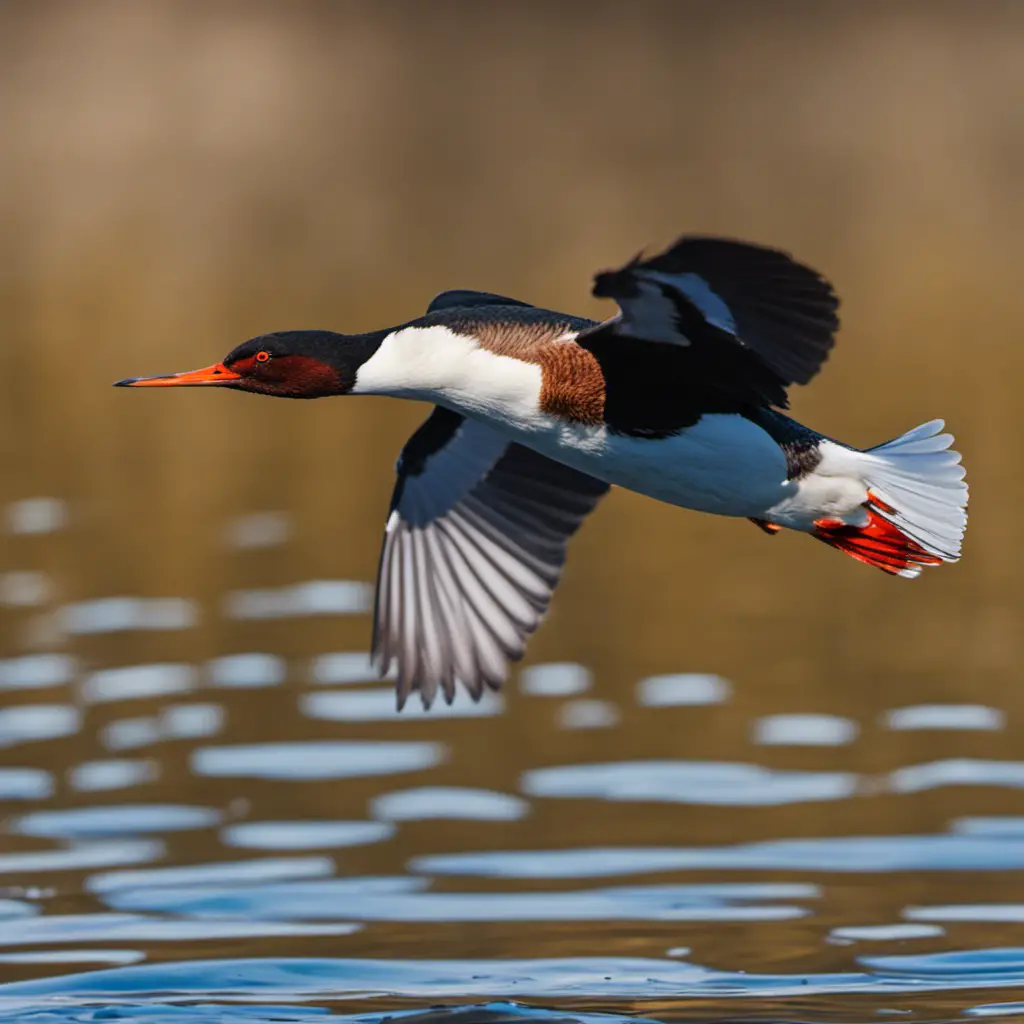
During the winter months, the Red-breasted Merganser, a diving duck species, can often be observed in Illinois wetlands, and its unique plumage and hunting behavior have sparked discussions among wildlife researchers and enthusiasts.
The Red-breasted Merganser is known for its striking appearance, with a long, thin bill, a shaggy crest, and a reddish-brown breast. It primarily inhabits freshwater habitats such as lakes, rivers, and wetlands, where it can find a sufficient supply of fish, its main diet.
The Red-breasted Merganser is an expert diver, capable of diving up to 60 feet in search of prey. Its diet mainly consists of small fish, including perch, trout, and minnows. These ducks are known for their fast-paced hunting style, chasing their prey underwater using their sharp bills to catch and consume their catch.
Understanding the red-breasted merganser’s habitat and diet is crucial for conservation efforts and maintaining the ecological balance of Illinois wetlands.
Common Goldeneye
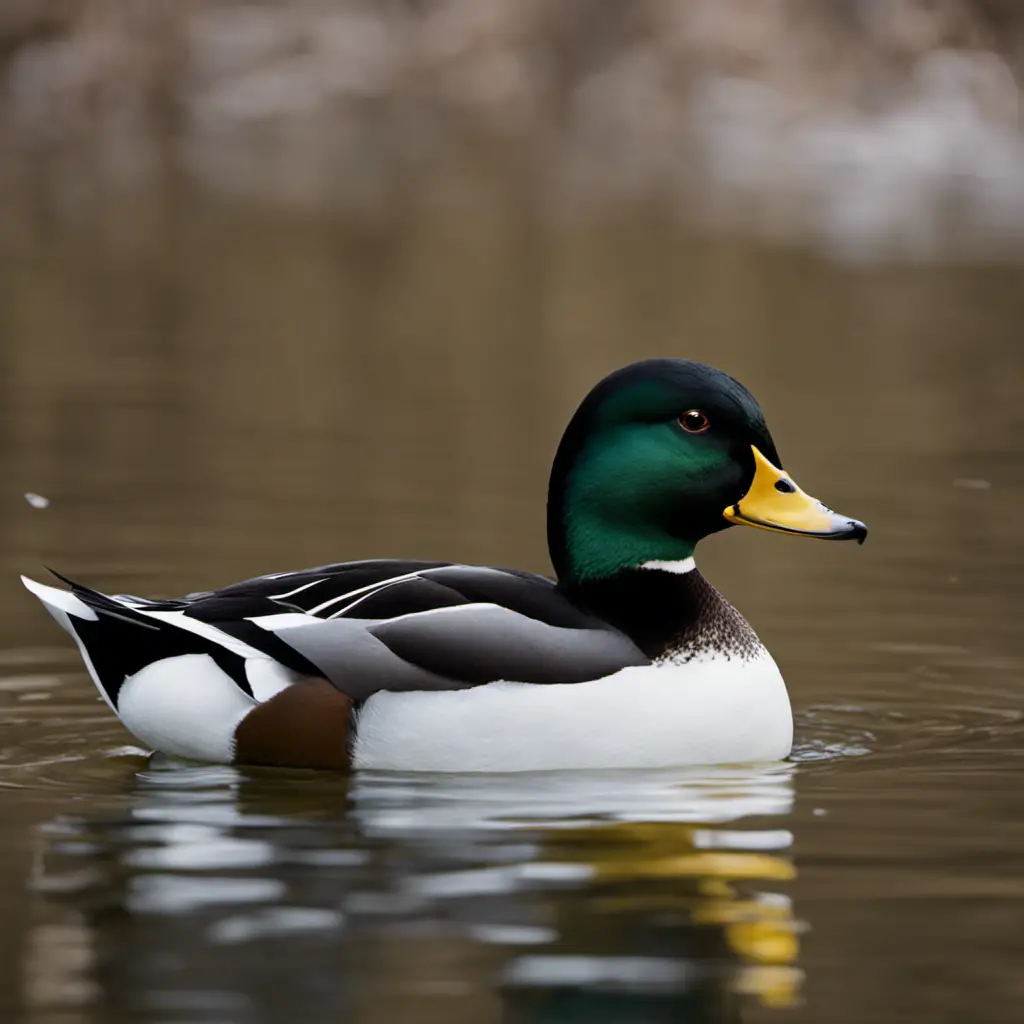
Frequently observed in Illinois wetlands, the Common Goldeneye, a medium-sized diving duck species, has become a topic of interest among wildlife researchers and enthusiasts due to its unique breeding behavior and distinctive black and white plumage. Here are three key aspects of the Common Goldeneye’s biology and behavior:
Goldeneye breeding habits:
- Mating displays: Male Common Goldeneyes perform elaborate courtship displays, including head-throwing, wing-flapping, and calling.
- Nesting behavior: These ducks nest in tree cavities near water bodies, often reusing old woodpecker holes.
- Egg-laying: Females lay an average of 8-10 eggs, which are incubated for about 28-32 days.
Goldeneye migration patterns:
- Wintering grounds: Common Goldeneyes migrate to the Great Lakes region and coastal areas for the winter.
- Long-distance travelers: Some individuals travel as far as the Atlantic and Pacific coasts during migration.
- Timing: Migration typically occurs in large flocks during the fall and spring.
Understanding these aspects of the Common Goldeneye’s biology can contribute to our knowledge of wetland ecosystems and aid in their conservation efforts.
Common Merganser
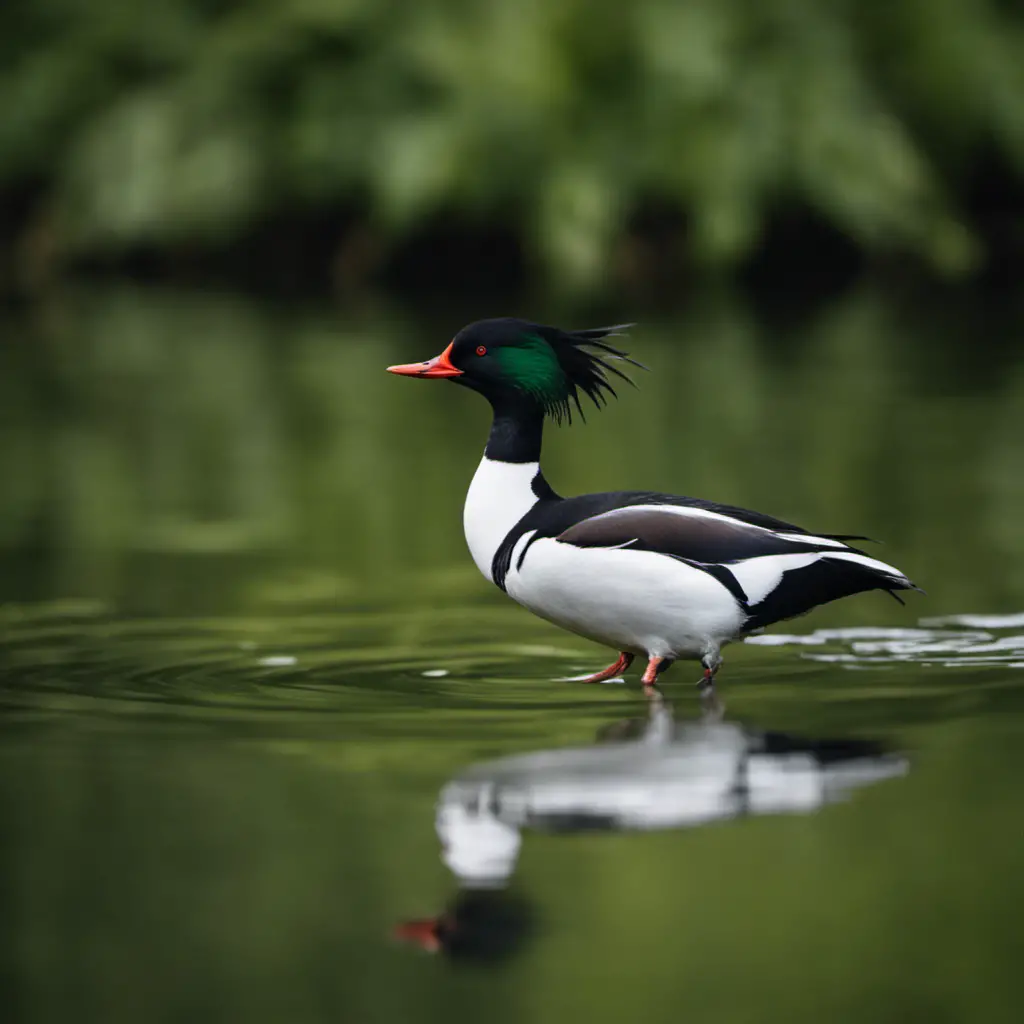
The population of Common Mergansers in Illinois has been steadily increasing, with an estimated 2,000 individuals observed during the annual waterfowl survey. This positive trend can be attributed to conservation efforts aimed at protecting their habitats and promoting nesting habits. Common Mergansers, also known as Mergus merganser, are large diving ducks that are commonly found near lakes, rivers, and wetlands. They have a distinctive appearance, with long, slender bodies, a crested head, and a sharp, serrated bill. These ducks are known for their exceptional fishing skills, using their sharp bills to catch and consume a variety of fish species. They are also skilled divers, capable of staying underwater for extended periods. The table below provides an overview of the nesting habits of Common Mergansers:
| Nesting Habits | |
|---|---|
| Nest Type | Tree Cavity |
| Clutch Size | 6-17 eggs |
| Incubation | 28-35 days |
| Fledging | 60-70 days |
| Nesting Site | Near water bodies |
Conservation efforts, such as habitat restoration and the creation of artificial nesting structures, have played a crucial role in supporting the increased population of Common Mergansers in Illinois. By understanding and protecting their nesting habits, we can continue to ensure the success of these beautiful and fascinating waterfowl.
White-winged Scoter

At this time, White-winged Scoter sightings have become increasingly common along the Illinois coast, especially during the winter months. These beautiful diving ducks are known for their striking black and white plumage, with a distinctive white patch on each wing.
Here are some interesting facts about White-winged Scoters:
Habitat:
White-winged Scoters prefer freshwater lakes, reservoirs, and coastal areas with rocky shores.
They can also be found in estuaries and bays during migration.
These ducks nest in the boreal forests of Canada and Alaska, often near small lakes or ponds.
Conservation efforts:
White-winged Scoters face threats from habitat loss, pollution, and disturbance caused by human activities.
Conservation organizations are working to protect their breeding grounds and important stopover sites during migration.
Efforts are also being made to reduce pollution and promote sustainable fishing practices to benefit their food sources.
Understanding the habitat requirements of White-winged Scoters and implementing conservation efforts is crucial for ensuring the long-term survival of this species. By protecting their habitats and reducing human impacts, we can help preserve these beautiful ducks for future generations.
Long-tailed Duck
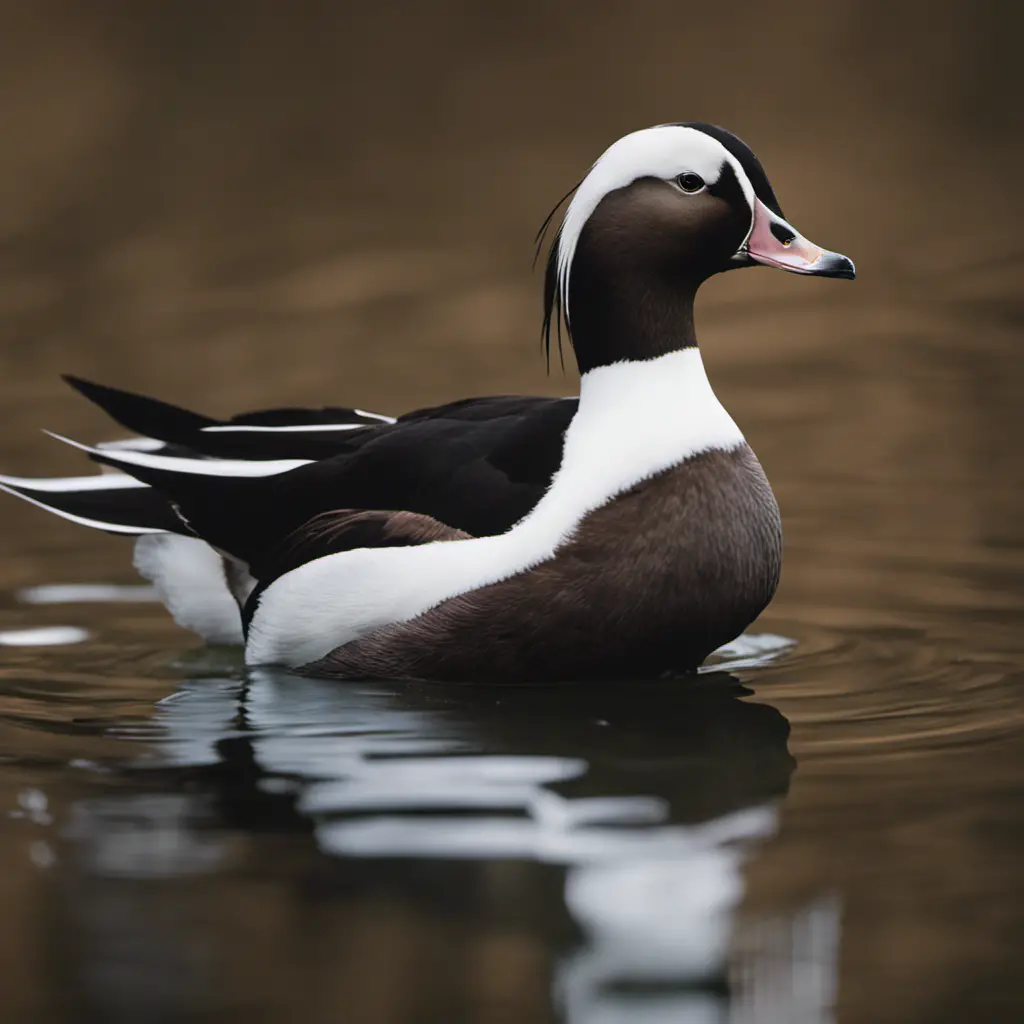
A recent study has revealed that Long-tailed Ducks in Illinois have shown a decline in population due to changes in their preferred wintering habitats.
Long-tailed Ducks, known for their distinctive long tail feathers, migrate to the Illinois area during the winter months. These ducks rely on large, open bodies of water such as Lake Michigan for foraging and resting.
However, the study found that climate change and human activities have altered the availability and quality of their preferred habitats. This has resulted in a decrease in the number of Long-tailed Ducks observed in Illinois.
To address this issue, conservation efforts are being undertaken to protect and restore their wintering habitats. These efforts aim to ensure that suitable conditions are available for the Long-tailed Ducks during their migration and to prevent further decline in their population.
Surf Scoter
Surf Scoter, a species of sea duck, is known for its striking black and white plumage, making it a popular subject of study among ornithologists. This species is primarily found along the coasts of North America, with a breeding range that stretches from Alaska to Labrador.
Surf Scoters are known for their long-distance migratory patterns, as they travel southward during the winter months to areas such as California and the Gulf of Mexico. However, recent research has shown that the population of Surf Scoters is declining, prompting conservation efforts to protect this species.
These efforts include habitat conservation, such as the preservation of coastal wetlands, as well as monitoring and management of hunting practices. Additionally, scientists are studying the specific migratory routes and stopover sites of Surf Scoters to better understand their needs during migration and ensure their survival.
Black Scoter
During the winter months, the Black Scoter can be found along the coasts of North America, where it migrates to areas such as California and the Gulf of Mexico. The Black Scoter (Melanitta americana) is a sea duck species that is known for its distinctive black plumage.
This species is primarily found in coastal marine habitats, where it feeds on a diet consisting mainly of mollusks and crustaceans. Black Scoters are known for their long-distance migrations, with individuals traveling thousands of kilometers each year in search of suitable breeding and feeding grounds. Understanding the migration patterns of Black Scoters is crucial for their conservation, as changes in habitat availability and environmental conditions can impact their population dynamics.
Conservation efforts for Black Scoters focus on habitat protection, reducing pollution, and minimizing disturbance in their breeding and wintering areas. Monitoring and research programs are also in place to gather data on their population trends, behavior, and ecological needs.
Wood Duck
The population of Wood Ducks in Illinois has been steadily increasing over the past decade, indicating successful conservation efforts and suitable breeding habitats. This is a positive trend for the species, as Wood Ducks are known for their stunning plumage and unique breeding behaviors.
Wood Duck Habitat:
Wood Ducks prefer forested wetlands with standing or slow-moving water.
They nest in tree cavities and use wetlands for feeding and roosting.
Suitable habitat includes flooded forests, swamps, and beaver ponds.
Wood Duck Breeding Behaviors:
Mating pairs form during the winter months and stay together until the end of the breeding season.
Females lay around 10-15 eggs in a nest cavity, usually located in a tree near water.
The male helps protect the eggs and chicks, but the female is responsible for incubation.
Overall, the increasing population of Wood Ducks in Illinois is a testament to the effectiveness of conservation efforts and the availability of suitable breeding habitats. Understanding their habitat requirements and breeding behaviors is crucial for furthering conservation efforts and ensuring the continued success of this species.
Blue-winged Teal
Recent studies have shown that Blue-winged Teal frequently utilize temporary wetlands for foraging and resting during their migration. These findings shed light on the migration patterns of this species and provide valuable insights into their behavior.
Blue-winged Teal, also known as Anas discors, are small dabbling ducks that breed in the northern prairies of North America and winter in the southern United States and Central America. They are known for their unique migration patterns, which involve long-distance flights between breeding and wintering grounds.
During their migration, Blue-winged Teal rely on temporary wetlands such as flooded fields and shallow ponds for feeding and resting. These wetlands provide abundant food resources, including aquatic invertebrates and plant matter, essential for the teal’s survival during their journey.
Understanding the utilization of temporary wetlands by Blue-winged Teal during migration is crucial for their conservation and management. Further research is needed to explore the specific factors that influence their choice of wetlands and the impact of wetland availability on their population dynamics.
Hooded Merganser
Frequently observed in Illinois wetlands, the Hooded Merganser, a small diving duck species with a distinctive fan-shaped crest, displays captivating courtship behaviors during the breeding season. Males perform elaborate displays to attract females, including head-throws, head-shakes, and crests raised to form a striking fan shape. This courtship behavior is not only visually stunning but also serves as a way for males to establish dominance and attract mates.
Hooded Mergansers have specific habitat preferences during the breeding season. They are commonly found in forested wetlands, particularly those with standing or slow-moving water. These ducks prefer areas with dense vegetation and tree cavities for nesting. They are also known to use artificial nest boxes provided by conservation organizations.
Hooded Mergansers are highly adaptable and can also be found in other wetland habitats, such as marshes, ponds, and rivers, as long as they offer suitable nesting and feeding opportunities. Overall, understanding the breeding behavior and habitat preferences of Hooded Mergansers is crucial for their conservation and management in Illinois wetlands.
Hooded Merganser breeding behaviors:
Elaborate courtship displays
Head-throws, head-shakes, and raised crests
Dominance establishment and mate attraction
Habitat preferences during breeding season:
Forested wetlands with standing or slow-moving water
Dense vegetation and tree cavities for nesting
Use of artificial nest boxes provided by conservation organizations
Adaptability to different wetland habitats:
Marshes, ponds, and rivers
Suitable nesting and feeding opportunities.
Frequently Asked Questions
What Is the Average Lifespan of a Wood Duck?
The average lifespan of a wood duck is around 5-6 years. However, with successful wood duck conservation efforts and favorable population trends, some individuals have been known to live up to 15 years.
How Does the Hooded Merganser’s Mating Behavior Differ From Other Duck Species?
The mating behavior of the hooded merganser differs from other duck species due to its unique courtship rituals. Unlike wood ducks, hooded mergansers engage in elaborate displays to attract mates, showcasing their crests and engaging in synchronized swimming patterns.
What Is the Preferred Habitat of the Surf Scoter?
The preferred habitat of the surf scoter is typically coastal areas, such as rocky shores or sandy beaches. These ducks are known to be highly migratory, often traveling long distances in search of suitable breeding and foraging grounds.
Are Northern Shovelers Known for Their Distinctive Bill Shape?
Northern shovelers are known for their distinctive bill shape, which is wide and flattened. This bill enables them to filter-feed on small invertebrates and plant matter in shallow water, using a side-to-side sweeping motion.
How Does the Behavior of the Lesser Scaup Change During Breeding Season?
During the breeding season, the behavior of the lesser scaup undergoes changes related to their breeding habits and courtship displays. These alterations in behavior are essential for successful reproduction and mate selection.
Are Finches Commonly Found in Illinois as Well?
Finches in illinois are indeed commonly found. With their vibrant colors and melodious songs, these small birds bring joy to many birdwatchers in the state. Whether you are in urban areas or rural landscapes, the chances of spotting finches in Illinois are high. Keep an eye out for their distinctive beaks and characteristic hopping movements.
Conclusion
In conclusion, this article has provided a scientific and objective overview of the various species of ducks found in Illinois.
The Mallard, Northern Pintail, Gadwall, Northern Shoveler, Ruddy Duck, Black Scoter, Wood Duck, Blue-winged Teal, and Hooded Merganser are among the notable species discussed.
Each species possesses unique characteristics and adaptations that allow them to thrive in their respective habitats.
Understanding the diversity of duck species in Illinois contributes to a better understanding of local ecosystems and aids in conservation efforts.

An avid ornithologist, zoologist and biologist with an unwavering passion for birds and wild animals.
Dr. Wilson’s journey in ornithology began in childhood and led him to obtain a Ph.D. in Ornithology from the prestigious Avian Research Institute. He has worked closely with renowned experts in the field and conducted extensive research and field studies globally.

